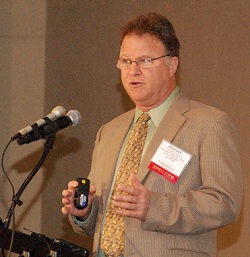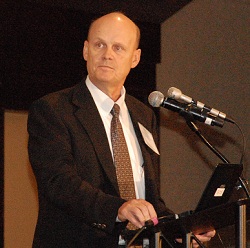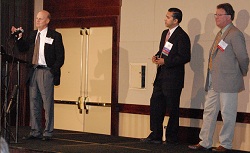This morning’s opening session of the 10th International Conference on Precision Agriculture (ICPA) was certainly a good one, as attendees heard that while the world’s farmers have increased the rate of growth of the food they produce, the current increase doesn’t match the rise in the human population and its rising incomes expected by the year 2050 when it’s expected that we’ll share this world with 9.2 billion people.
 Dr. Ken Cassman with the University of Nebraska’s Center for Energy Sciences Research told the standing-room-only crowd that without negatively impacting some of the world’s most sensitive ecosystems – the rain forests, wetlands, and grassland savannahs – the current rate of production growth won’t meet the rising demand. He says a process of increasing yields and reducing agriculture’s “footprint” is necessary: a process he calls “ecological intensification (EI).” And he believes precision agriculture could play a key role in that process.
Dr. Ken Cassman with the University of Nebraska’s Center for Energy Sciences Research told the standing-room-only crowd that without negatively impacting some of the world’s most sensitive ecosystems – the rain forests, wetlands, and grassland savannahs – the current rate of production growth won’t meet the rising demand. He says a process of increasing yields and reducing agriculture’s “footprint” is necessary: a process he calls “ecological intensification (EI).” And he believes precision agriculture could play a key role in that process.
“The buffer between proper management and poor management narrows, that is, the margin for error becomes smaller in terms of what helps the crop or what hurts the crop. So your precision of management becomes the single most important factor in helping farmers achieve yields near the yield potential ceiling.”
Cassman says the goal is to achieve 80 percent of a crop’s genetic yield potential while not increasing the impact that crop has on the environment. He says while biotechnology might help get us there, there is no magic bullet. It will take a combination of new technologies and techniques to hit that potential.
 And a man who shared the stage with Cassman during the opening session believes we cannot play down the importance of testing and monitoring of fields to make sure the crops are living up to their potential. Dr. William Raun with Oklahoma State University also made a pitch for funding of extension services so that testing can take place.
And a man who shared the stage with Cassman during the opening session believes we cannot play down the importance of testing and monitoring of fields to make sure the crops are living up to their potential. Dr. William Raun with Oklahoma State University also made a pitch for funding of extension services so that testing can take place.
“Extension is obviously important to us. We cannot just do research. We’ve got to have thousands of enrich strips and ramps out there in the fields and investing in that extension so farmers can see it.” And he adds that the numbers and formulas are out there to best forecast what can happen in a field. We just need to make sure it’s measured. “Yield potential can be predicted.”

It really was a great session. Because of the length of it, I can’t post all of the audio here, but I am going to let you hear the question and answer session after Cassman’s and Raun’s presentation. You’ll also hear from Dr. Raj Khosla during this segment. You can download or listen to this session at ICPA here: [wpaudio url=”http://zimmcomm.biz/leica/icpa-10-leica-qanda.mp3″ text=”Opening Session Questions and Answers”]
I’ve also posted the day’s pictures on the ICPA Photo Album




 For farmers who deal with the planting and spraying challenges of farming on contours, terraces and hills, there’s a new guidance pattern from Ag Leader Technology that offers help.
For farmers who deal with the planting and spraying challenges of farming on contours, terraces and hills, there’s a new guidance pattern from Ag Leader Technology that offers help.




 As a agricultural journalist originally from a rural Iowa family farm, who now lives in suburbia close to Minneapolis, I’m always educating urban friends about farming and correcting their misconceptions.
As a agricultural journalist originally from a rural Iowa family farm, who now lives in suburbia close to Minneapolis, I’m always educating urban friends about farming and correcting their misconceptions.